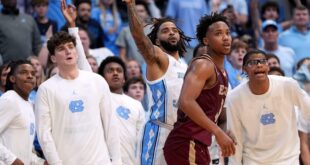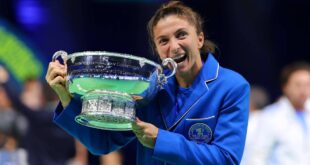It’s a long wait from the first weekend in April until the first week of November, but at last, the men’s college basketball season is upon us.
We’ve already shared The Athletic’s preseason conference rankings, full of stats and analysis. We’ve rolled out our preseason All-America teams and Top 25. And there’s plenty more to come. Consider this my first national column, which will regularly cover the week that was and preview the weekend that will be.
So, before the games actually tip off, let’s get you caught up on everything you need to know.
1. UConn’s quest for a three-peat is historic — but not impossible
Last season, Connecticut became just the third program in the modern era to win back-to-back national titles, joining Florida (2006 and 2007) and Duke (1991 and 1992).
But neither the Gators nor the Blue Devils were able to run things back a third time. Which means the only team that’s ever won three straight is still John Wooden’s UCLA dynasty, which won seven consecutive championships from 1967 to ’73 (and 10 over a 12-year span). But Dan Hurley wouldn’t have turned down the Los Angeles Lakers’ head-coaching job this summer if his team didn’t have a realistic shot at cutting down the nets (again) in 2025.
Beyond the difficulty of winning a single-elimination tournament three years running is that Hurley, 51, keeps losing his best players. After his first title, three starters left for the NBA. After UConn won it all again, Hurley lost four more starters. At least Hurley convinced redshirt junior Alex Karaban to come back … but now he needs the 6-foot-9 forward to go from highly efficient role player to a true All-American.
Karaban will get help from guard Aidan Mahaney (Saint Mary’s) and center Tarris Reed Jr. (Michigan), both top-50 transfers according to The Athletic’s list of best available players, and five-star wing Liam McNeeley was the No. 17 recruit in the nation. Hurley also needs his role players from the past two seasons to take the leap. There’s enough talent here to make another run. And if UConn does? It would cement Hurley not just as the best coach of the modern era, but one of the best the sport has ever seen.
2. The coaching carousel
Who knew that SMU firing Rob Lanier would be so consequential?
But that became the first domino in a wild offseason. SMU, ahead of its move to the ACC, quickly hired Andy Enfield away from USC, which paved the way for Eric Musselman to leave Arkansas for Los Angeles. The Razorbacks responded with a home run swing: luring Hall of Famer John Calipari away from his lifetime contract at Kentucky as his act appeared to be wearing thin in Lexington. (A blue-blood coaching change, for the fourth straight offseason.)
Kentucky settled on BYU coach Mark Pope — a captain on UK’s 1996 championship team — as Calipari’s successor, after its pursuit of Baylor coach Scott Drew came up short. BYU hired former Phoenix Suns assistant Kevin Young, who has seemingly unlocked the Cougars’ name, image and likeness vault.
POV: You are in section 224 during @CoachMarkPope‘s introduction during #BBM24. pic.twitter.com/Vchb6UQ1a5
— Kentucky Men’s Basketball (@KentuckyMBB) October 14, 2024
Those interconnected dominoes don’t even factor in Michigan winning the sweepstakes for Dusty May, who took Florida Atlantic to its lone Final Four. Louisville, which ended its disastrous two-year Kenny Payne experiment, pivoted to Charleston’s Pat Kelsey.
Tony Bennett’s recent abrupt retirement from Virginia, where he hung the program’s only national championship banner in 2019, left the ACC without a championship-winning coach for the first time since 1981-82. Ron Sanchez (former head coach at Charlotte) was named interim coach and will have every opportunity to win the full-time job. And lastly, tragically, South Florida coach Amir Abdur-Rahim — who led Kennesaw State to its first NCAA Tournament appearance and was a rising star — died last week at age 43 due to complications from a medical procedure. Assistant Ben Fletcher will be the interim.
3. Zach Edey is gone, but there’s still returning star power
Edey — the first two-time Wooden Award winner since Ralph Sampson in the 1980s — is gone to the NBA, but The Athletic’s preseason All-America teams include several accomplished players.
North Carolina guard RJ Davis is the only first-team All-American back from last season, but two second-team honorees also return: Alabama guard Mark Sears and Kansas center Hunter Dickinson. (Thank the extra COVID-19 year of eligibility for guys sticking in school long enough to become household names.) Karaban is the face of UConn’s bid for a three-peat, Arizona guard Caleb Love is two seasons removed from ending Mike Krzyzewski’s Hall of Fame career, and Purdue guard Braden Smith is set to step out of Edey’s enormous shadow.
That’s just a snippet of the talent back. But there’s also …
4. Cooper Flagg, the most hyped high school prospect since …?
Welcome to the year of Flagg. The 6-foot-9 Maine native was the top-ranked recruit in this year’s freshman class, and he’s long been the front-runner to go No. 1 in the 2025 NBA Draft. It’s not hyperbolic to call him the most-anticipated high school recruit since Anthony Davis at Kentucky in 2011-12. And the nine months “The Brow” was on campus turned out pretty well for the Wildcats, no? Duke and third-year coach Jon Scheyer are hoping Flagg leads the Blue Devils to similar national championship heights — and talent-starved NBA fans in Washington, Brooklyn and Detroit are watching just as eagerly.
Flagg’s hype train hit a new gear after his performance this summer at Team USA camp. Despite being the lone college representative on the Select Team — which featured rising NBAers like Brandon Miller and Jalen Suggs — Flagg was, at times, the best player on the court.
Flagg is a better defensive player than offensive one at this point, but he can still pour it in as a scorer. Regardless, Duke’s do-everything centerpiece will have a spotlight trained on him for good reason: He’s the rare talent, even at 17, who can lead a team to a national championship.
COOP &1 @Cooper_Flagg pic.twitter.com/P9pCUnbjuf
— Duke Men’s Basketball (@DukeMBB) October 28, 2024
5. Experience rules
When the 2020 NCAA Tournament was canceled due to COVID-19, the NCAA granted every player that season an additional year of eligibility. In the final season with those players still active, what is the legacy of that decision? The most experienced era in the recent history of the sport.
According to NCAA data, in 2018-19 — the final full season before the pandemic — the average experience level for DI men’s players was 2.41 years; for this season, it’s up to 2.62. But that data isn’t totally representative because it counts fifth-year players like normal seniors. If it accounted for the additional year, the average is pushed even higher. Take Xavier, the most experienced high-major team in the country this season. The Musketeers’ average experience is 3.35 years, per NCAA data. But if you account for the team’s eight fifth-year players, that figure rises to 3.53.
As for how experience correlates to winning? There have been only two freshman starters in the past two Final Fours combined, both for UConn: Karaban (2023) and Stephon Castle (2024). Duke, or another freshman-heavy team, may reverse that narrative this season. But recent history suggests experience is more valuable than ever.
6. Rutgers has 2 of the nation’s top 3 recruits
The only school in the past decade to land two of the nation’s top three recruits was Duke, until this summer. But by signing forward Ace Bailey (No. 2 nationally, per the 247Sports Composite) and point guard Dylan Harper (No. 3), Rutgers coach Steve Pikiell has accomplished the seemingly impossible in New Jersey. (The wonders that a family legacy — Harper’s older brother, Ron Harper Jr., also played at Rutgers — and a robust NIL pitch can do.)
Both Bailey and Harper are projected top-five picks in next summer’s NBA Draft — and they could even challenge Flagg to go first if they lead the Scarlet Knights to the NCAA Tournament.
At 6 feet 6 and 215 pounds, Harper has ideal size for a lead guard, and he offers polished three-level scoring ability. Bailey is more raw, but there aren’t many prospects with his athleticism at 6 feet 10. They’ll be asked to carry a heavy load in a Big Ten predicated on physicality and post play.
7. Another transfer portal cycle sees top names find new homes
Where did some of the top names wind up? Former Final Four participants — point guard Jeremy Roach (Duke) and forward Norchad Omier (Miami) — will team up at Baylor this season. The remaining cornerstones from Florida Atlantic’s 2023 Final Four team scattered, as well; center Vlad Goldin followed May to Michigan, guard Johnell Davis went to Arkansas, while guard Alijah Martin stayed in Florida and joined the Gators.
Tucker DeVries — the two-time Missouri Valley Player of the Year and the No. 1 transfer in The Athletic’s rankings — went with his father, Darian, to West Virginia. New Saint Louis coach Josh Schertz brought his best player, the goggle-wearing Robbie Avila, with him from Indiana State. Forward Great Osobor moved from Utah State to Washington to stay with coach Danny Sprinkle.
Coleman Hawkins (Illinois) picked Kansas State. Rylan Griffen left one Final Four team (Alabama) for another potential one (Kansas). Louisville brought in an entire new roster, headlined by Chucky Hepburn (Louisville), Terrence Edwards Jr. (James Madison) and Kasean Pryor (USF). We could go on.
8. Can the Big Ten end its 25-year national title drought? It looks unlikely
No Big Ten team has won it all since Tom Izzo captured his first (and only) title with Michigan State in 2000.
Since then, eight Big Ten teams — Indiana (2002), Illinois (2005), Ohio State (2007), Michigan State (2009), Michigan (2013), Wisconsin (2015), Michigan (2018) and Purdue (2024) — have made it to the championship game, but none have finished the job. Eleven coaches surveyed by The Athletic largely agreed that probably speaks more to the randomness of March Madness than any overarching condemnation of one conference but also spoke to style of play.
It seems unlikely the Big Ten snaps its dry spell this season. Purdue is the top-ranked preseason team in the league at No. 14, followed by Indiana (No. 17), UCLA (No. 22) and Rutgers (No. 25). There just doesn’t appear to be one or two clear front-runners. However …
9. Could we see a record for NCAA Tournament teams from one league?
The Big East holds the single-season record for NCAA Tournament bids by one league, when 11 of its 16 teams qualified in 2011. But with conference realignment leading to larger high-major leagues, will the record be broken this season?
Possible, but still improbable. Three leagues seem best-positioned: the SEC, Big Ten or Big 12. The SEC has nine teams ranked in the preseason Top 25 and a 10th (Mississippi State) that received votes in the poll. The Big Ten has seven others who received preseason votes in addition to the four ranked. The Big 12 is top-heavy; six of its teams are ranked, with the potential for more to emerge from its meaty middle class.
Even if it doesn’t happen this season, we expect that 11-bid mark to eventually be topped. It could also fall soon if there is moderate NCAA Tournament expansion, which could be implemented as soon as the 2026 bracket. Over the summer, The Athletic reported that the NCAA had presented proposals for both a 72- and 76-team field to DI conference commissioners. Under both proposals, the First Four would be expanded to include at least four more at-large teams.
How much of an appetite is there to expand the 68-team field? Enough, although not to a major extent. But multiple high-major conference commissioners — including the SEC’s Greg Sankey and the ACC’s Jim Phillips — have previously expressed an interest in exploring tournament expansion. Talks remain ongoing.
10. Final Four predictions
In our staff survey, 11 teams earned Final Four votes: Gonzaga (8), Alabama (6), UConn (5), Houston (5), Kansas (5), Iowa State (4), Duke (2), Baylor (2), Arizona, Arkansas and Texas A&M.
Of those schools, five were picked as the preseason national champion at least once — but none more than Gonzaga, whom three of our experts picked to deliver Mark Few’s long-awaited first title. (The others? Alabama, Kansas, UConn and Houston.) That group makes up the clear top cluster of teams expected to compete to win it all.
11. Cheers to the schedule-makers for great opening-week games
Here are 10 of the opening-week matchups circled on our calendar, featuring 10 different ranked teams (times ET):
Monday
No. 13 Texas A&M at UCF, 7 p.m.
Missouri at Memphis, 8 p.m.
No. 19 Texas vs. Ohio State, 10 p.m.
No. 8 Baylor at No. 6 Gonzaga, 11:30 p.m.
Friday, Nov. 8
No. 9 North Carolina at No. 1 Kansas, 7 p.m.
Saturday, Nov. 9
No. 12 Tennessee at Louisville, noon
No. 8 Baylor vs. No. 16 Arkansas, 7:30 p.m.
Northwestern at Dayton, 7:30 p.m.
No. 11 Auburn vs. No. 4 Houston, 9:30 p.m.
Sunday, Nov. 10
Michigan vs. Wake Forest, 1 p.m.
(Photo of UConn’s Alex Karaban: Brett Wilhelm / NCAA Photos via Getty Images)
 meganwoolsey Home
meganwoolsey Home



